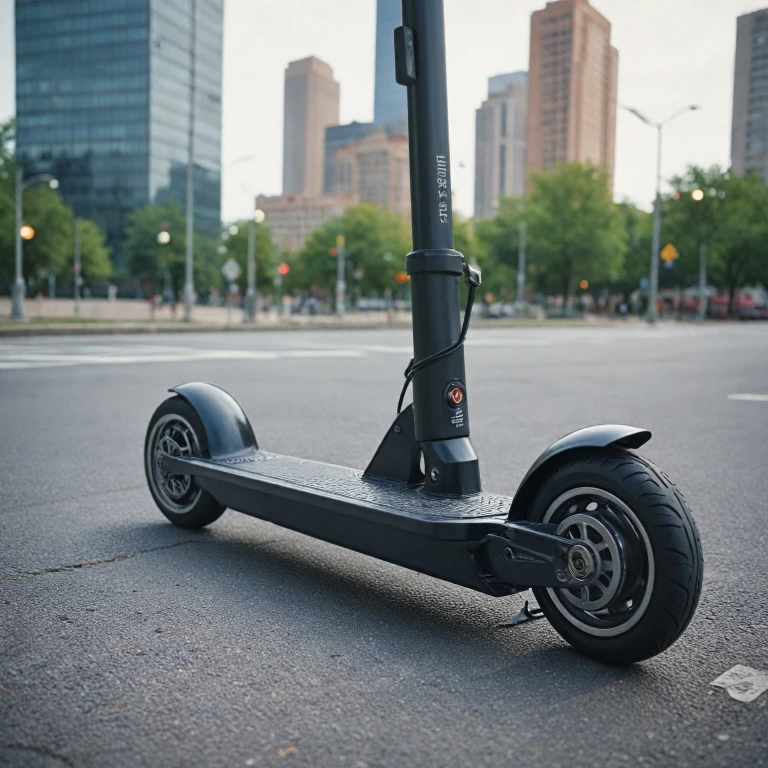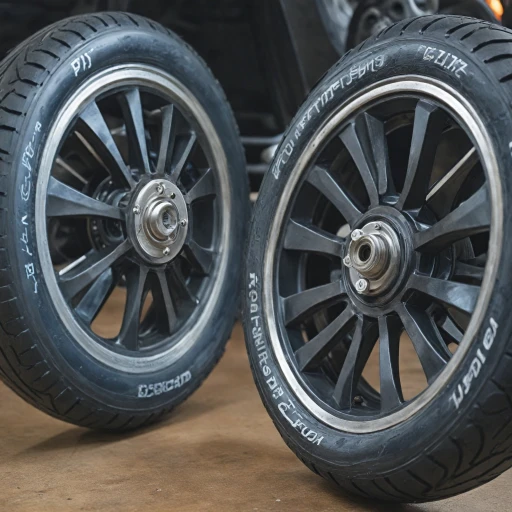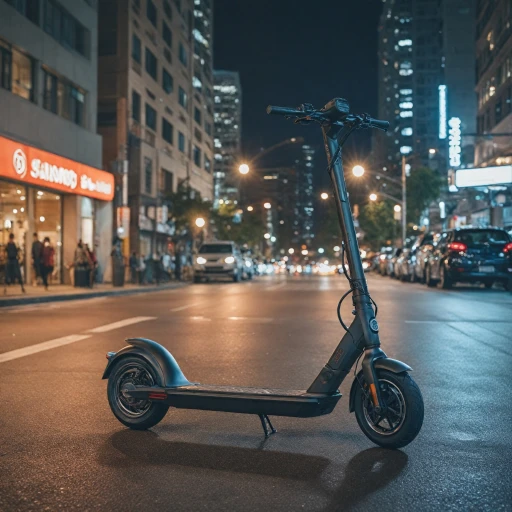Types of Electric Scooter Wheels
Variety of Wheels in the Electric Scooter Realm
Electric scooters come equipped with different types of wheels, serving varying purposes and catering to distinct needs. Understanding these differences will help you make an informed choice when purchasing or replacing parts for your electric scooter.- Solid Wheels: These are often favored for their durability and the low maintenance they require. They don't suffer from flats like tires with inner tubes, making them ideal for urban commuters. However, their rigidity can lead to a less smooth ride, especially on bumpy roads.
- Air-Filled or Pneumatic Wheels: These wheels have tires that must be inflated, usually with an inner tube. They offer better shock absorption, providing a comfortable ride even on uneven surfaces. Keep in mind that they require regular inflation checks and can be prone to punctures.
- Tubeless Tires: This type bridges the gap between solid and pneumatic tires. While they still provide good shock absorption, like their pneumatic counterparts, they don't need an inner tube, reducing the risk of flats somewhat.
Wheel Size and Its Impact on Ride Quality
Size Matters: How Wheel Dimensions Influence Your Ride
Choosing the right wheel size can significantly impact your riding experience on an electric scooter. Wheel dimensions are often an overlooked aspect, but they play a crucial role in the overall performance and comfort of your ride. Let's explore how different wheel sizes can affect your scooter journey.
Smaller wheels, typically under 8 inches, are common among regular scooters due to their cost-effective prices and lightweight features. However, they might not absorb shocks effectively on uneven terrains, leading to a bumpier ride. These wheels are ideal for smooth, city pavements where maneuverability and quick stops are necessary without much concern for rough surfaces.
Conversely, larger wheels, ranging between 8 and 12 inches, generally promise a smoother ride over various terrains. Their enhanced capacity to handle small obstacles, like stones or debris, makes them a popular choice for those who might encounter diverse surfaces. Larger wheels can also provide better stability, which is crucial when riding at higher speeds.
Tire and tube choices further influence ride comfort. Pneumatic tires, filled with air tubes, offer better shock absorption than solid ones, making them preferable for those seeking a cushioned ride. However, they require regular maintenance to prevent flats. For enhanced comfort, consider upgrading your Unagi E500 tires.
Ultimately, the size of the wheel you choose should align with your specific needs and preferences, whether your priority is a smoother, more comfortable ride or a more agile and lightweight experience. Additionally, always consider the conditions you'll frequently encounter in your regular commute.
Materials Used in Electric Scooter Wheels
The Essential Ingredients in Electric Scooter Wheels
When diving into the intricacies of electric scooter wheels, one cannot overlook the materials used in their construction. These components are crucial, affecting everything from ride quality to the durability and price of the scooter. Let's break down the key materials that make up these indispensable parts of an electric scooter.- Rubber: The tire, often crafted from premium rubber, plays a significant role in ride comfort and traction. Solid rubber tires are popular for their durability, but pneumatic tires—those filled with air—offer superior cushioning and grip, adapting well to regular and uneven surfaces.
- Metal Alloys: The rims and axles are typically made from robust metal alloys. Aluminum is a common choice, renowned for being lightweight yet strong, helping to maintain the scooter’s overall speed without compromising sturdiness. Steel is another option, providing enhanced durability but often at a higher weight.
- Plastic Compounds: High-grade plastics are sometimes employed in less stressed areas of the wheel, such as protective caps or decorative parts, ensuring a lighter scooter overall while still providing cost-effective replacement options.
Maintenance Tips for Electric Scooter Wheels
Tips for Prolonging the Life of Your Scooter's Wheels
Maintaining the wheels of your electric scooter is crucial for ensuring a smooth and safe ride, as well as prolonging the overall lifespan of the parts. Here are some easy-to-follow maintenance tips that will keep your wheels in top shape:- Regular Check-Ups: Frequently inspect your wheels for any signs of wear and tear, such as cracks on the rims, tire tread wear, or flat spots.
- Proper Inflation: Always check the tire pressure, keeping it within the recommended range specified by the scooter manufacturer. This not only enhances the ride quality but also prevents potential damage to your wheels. Under-inflation can lead to a blowout, while over-inflation might affect the grip and handling.
- Wheel Alignment: Misaligned wheels can cause uneven tire wear and affect the scooter's performance. Routinely check the alignment of both the front wheel and rear wheel to ensure they are properly set.
- Axle and Bearing Care: Periodically lubricate the wheel bearings and axle to reduce friction, which ensures a smoother ride and extends the life of the unit.
- Inspection of Spare Parts: Regularly check spare parts like inner tubes and replacement tires for availability, and purchase quality spares for seamless replacements when needed. This is especially important if you frequently ride on rough terrain that can wear out parts faster.
Common Issues with Electric Scooter Wheels
Identifying and Addressing Wheel Challenges
Electric scooter wheels can face common issues, affecting both performance and safety. Understanding these challenges helps in maintaining an optimal ride experience and can save costs in the long run.
- Punctures and Flats: The most frequent issue with scooter wheels is punctures, especially with pneumatic tires. Ensuring the inner tube is in good condition and opting for tires designed for flat prevention can reduce the risk of punctures.
- Wear and Tear: Over time, regular use leads to thinning tires. Analyzing tread patterns for even wear is crucial. Consistently worn tires should be replaced to maintain proper grip and safety.
- Unbalanced Wheels: An unbalanced rim affects ride comfort and may lead to premature wear of other scooter parts. Regular checks of the axle and tightening wheel bearings help in maintaining balance.
- Loose Axles: Misaligned or loose axles can be hazardous. Regular inspection ensures that they are securely fastened, minimizing risks on bumpy terrains.
- Brake Issues: Inefficient brakes can result from worn or improperly aligned wheels, especially important in the rear wheel. Monitoring and adjusting the brake often curtails this issue.
Addressing these problems early is crucial for extending the lifespan of your electric scooter wheels and ensuring a safe ride. For more insights on maintaining and selecting the best wheel materials, revisiting our guide on wheel materials in electric scooters is recommended.
Choosing the Right Wheels for Your Riding Needs
Finding the Ideal Wheels for Your Riding Preferences
Selecting the ideal electric scooter wheels involves consideration of various factors, including budget, terrain, and personal riding style. The right wheels can make a significant difference in both the performance and safety of your scooter. Here’s how to make the best choice:- Determine Your Riding Terrain: If you primarily ride on smooth, urban streets, you may find smaller wheels more efficient due to their light weight and ease of handling. For rougher terrains, such as gravel or uneven paths, larger wheels can provide better stability and shock absorption.
- Consider Wheel Composition: The materials used in wheels can dramatically affect performance. Solid rubber wheels offer durability and puncture resistance, while pneumatic tires provide a smoother ride with better traction. Consider your need for maintenance and the frequency of use when choosing between the two.
- Analyze Wheel Size and Rim Type: Larger wheels with proper rims handle impacts and obstacles more efficiently, improving the ride quality. When selecting wheels, factor in the balance between wheel size and the rim's ability to support those wheels without increasing the scooter's weight dramatically.
- Assess Price and Value: Evaluate the price relative to quality and performance. Electric scooters and their parts come at a range of price points, from budget units to high-end models. Prioritize wheels that offer the best mix of durability and cost-effectiveness, considering both the upfront cost and potential long-term savings on repairs and replacements.
- Check Compatibility and Spare Parts Availability: Ensure the wheels you choose are compatible with your scooter model, addressing fit and axle specifications. Verify that replacement parts like tubes, brakes, and bearings are readily available to avoid lengthy downtimes during maintenance.
- Think About Customization Needs: Some riders prefer customization for aesthetic or functional reasons, such as opting for specific tire treads or color schemes. Evaluate if any upgrades, such as the electric scooter brakes or front wheel, meet these requirements within your budget.




